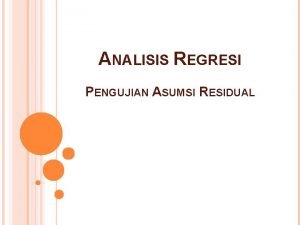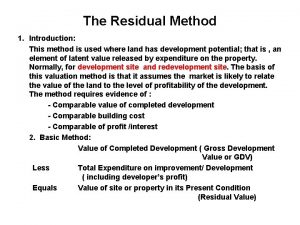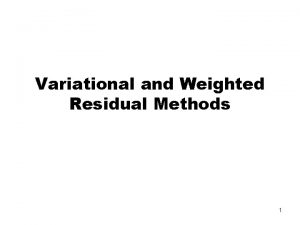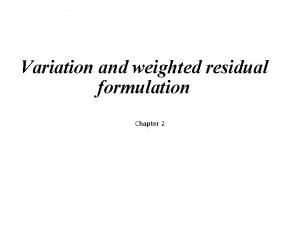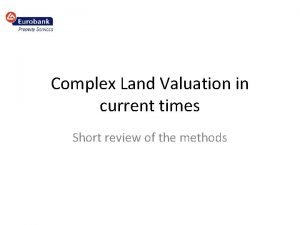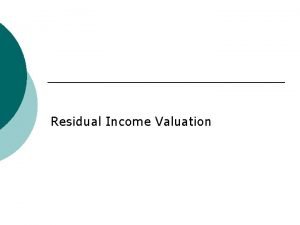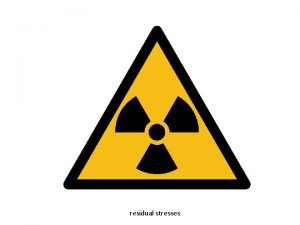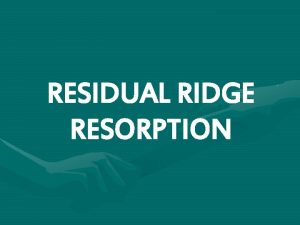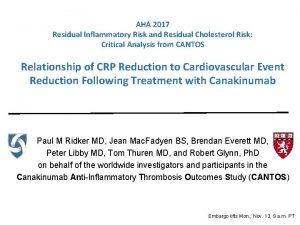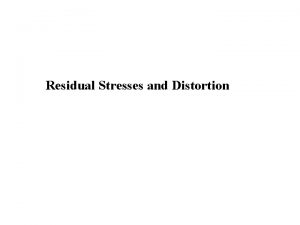The Residual Method 1 Introduction This method is








- Slides: 8

The Residual Method 1. Introduction: This method is used where land has development potential; that is , an element of latent value released by expenditure on the property. Normally, for development site and redevelopment site. The basis of this valuation method is that it assumes the market is likely to relate the value of the land to the level of profitability of the development. The method requires evidence of : - Comparable value of completed development - Comparable building cost - Comparable of profit /interest 2. Basic Method: Value of Completed Development ( Gross Development Value or GDV) Less Total Expenditure on improvement/ Development ( including developer’s profit) Equals Value of site or property in its Present Condition (Residual Value)

The Residual Method a. Value of completed development: Residential : Direct capital value comparison- assessing the future sale value on current residential sales of similar property. Commercial : Investment Method of valuation- capitalizing the total achievable rent at an appropriate yield. Leisure : Account Method – predicting future cash flow based on comparable evidence of similar business enterprises. b. Total Expenditure on Improvement or Development; Sub-divided into a number of constituent parts: * Building Costs – gross area used with associated items such as site clearance, demolition etc.

The Residual Method b. Total Expenditure on Improvement or Development; Sub-divided into a number of constituent parts: * Building Costs – gross area used with associated items such as site clearance , demolition etc. * Professional Fee – 12 and 15% of construction cost. * Finance – for total building cost, land cost and professional fee * Advertising and Marketing- depends on the program, 0. 5% to 1% of GDV * Voids and Contingencies – empty after the development is completed. 3 – 5% o n building cost * Developer’s Profit and Risk – 15 – 20% on GDV or 20 -25% on total cost

The Residual Method c. Value of Site or Property in its Present Condition: Less Equals The Value of completed development The total estimated costs Value of site or property in its present condition (residual Value)

The Residual Method 3. Example 1 : Calculate the site value of 5 hectares of land, for which planning permission has been granted for the building of bungalows at a density of 20 bungalows per hectare. The development will be completed within 2 years of commencement of building and it is anticipated that bungalows will sell at £ 14, 000 each Solution: Sale price of 100 bungalows at £ 14, 000 each = £ 1400, 000 Less Cost of Building : 80 m² at £ 100/m² = £ 8000 x 100 =£ 800, 000 Cost of roads and sewers: 800 m at say £ 70/m =£ 56, 000 Other site works, say =£ 2, 000 Architect’s and quantity surveyor’s fee, say 10% of cost =£ 85, 800 Legal costs, advertisement and estate agency fees, say 3% of value Interest on capital borrowed for 1 year @18% of Contingencies, say Developer’s profit, say 10% =£ 42, 000 = £ 154, 440 =£ 5, 000 =£ 114, 524 £ 1, 259, 764 £ 140, 236 PV of £ 1 in 1 year at 8% = Site value =£ 129, 858 say £ 129, 850 0. 926

The Residual Method 3. Example 1 (cont) - The developer may have to borrow capital to purchase the site; a deduction from the £ 129850 would be made to allow for the interest repayment. - The gross area for each bungalow is 80 m²; floor areas depend on individual designs and layout. - Fees are based on the assumption that professional scales of fees are applied; the developer may, however, employ his own professional staff, who are paid salaries. - It is assumed that capital would be borrowed for 1 year only at a rate of 18% per annum. Some developers may, however, finance the development with income derived from other schemes, but they would expect some return for the use of his income. - Contingencies are included to allow for such items as emergencies and increased building cost. - The rate of profit will vary from developer to developer and from scheme to scheme - Both income and expenditure have been deferred for 1 year; this assumes that some bungalows would be sold within 1 year of commencement of the scheme, and that all the expenditure would not be undertaken immediately

The Residual Method 3. Example 2 and assessment question: Please refer to given notes for the detailed calculation.

The Residual Method 4. Conclusion: Normally used to advise clients on the potential value of land Many variable factors involved in the calculation. Relatively small differences in approach in individual parts of the valuation can produce considerable variations in the final answer
